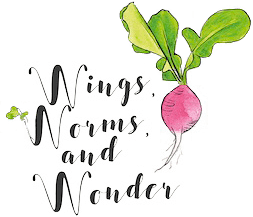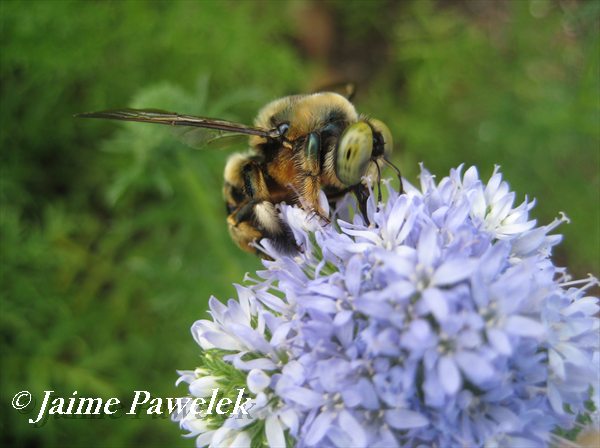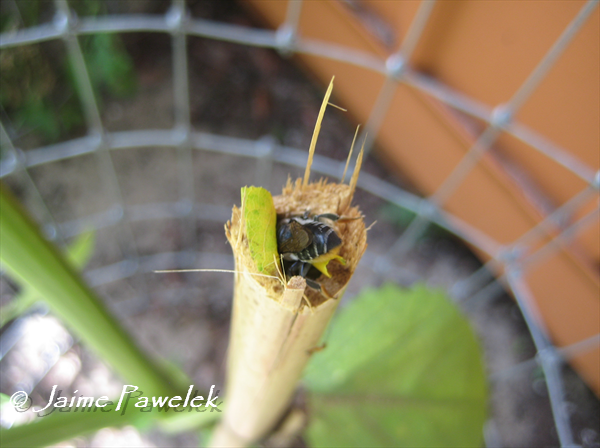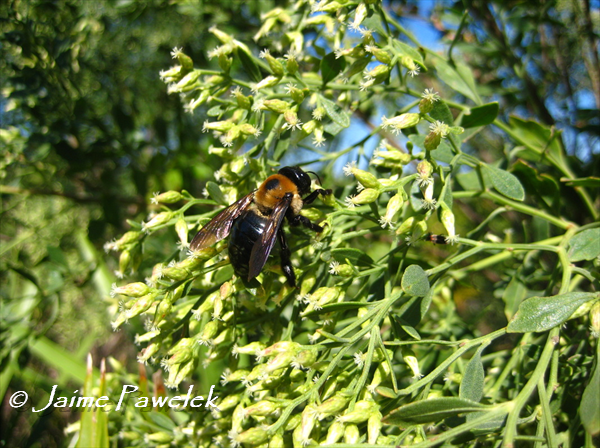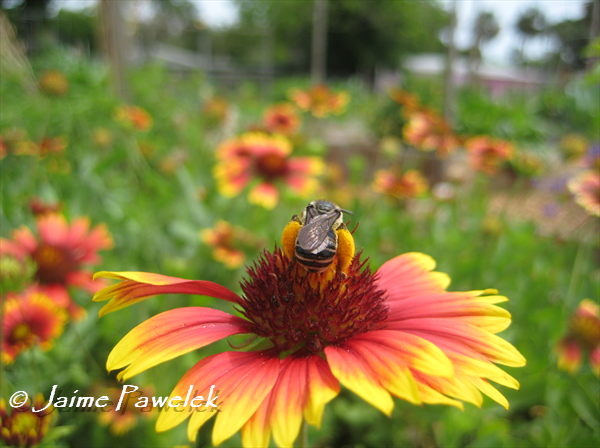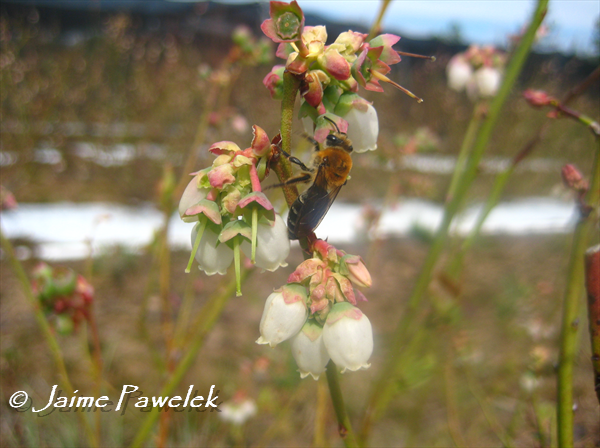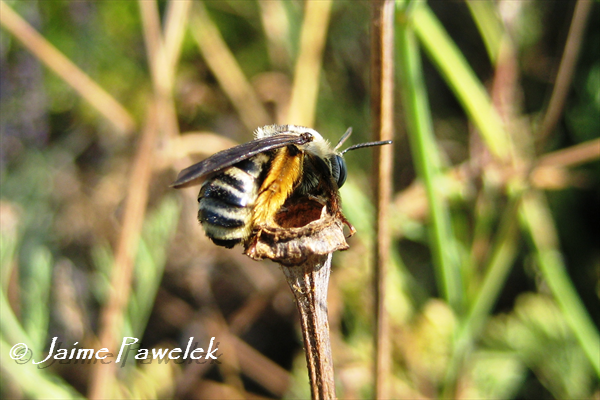The Wonderful World of Native Bees: Guest Post by Jamie Pawelek!
I am so happy to present this incredible guest post by Tuesday’s interviewee, bee expert and researcher, and nature photographer Jamie Pawelek. (Who also happens to make some of the most delicious vegan popsicles, sorbet, and cookies I have ever tasted! Did you not love her sorbet Bicycle market stand pic?) She has that perfect balance of science and creativity that the Nature-Study advocates stressed the importance of!
Male carpenter bee (Xylocopa micans) on blue globe gilia (Gilia capitata)
Honeybees may get all the fame and glamour, but our native bees are just as important to consider and are often overlooked. Get ready to learn about the many amazing native bees in your yard, why they are so important, and what you can do to make their lives a work a little easier!
The Wonderful World of Native Bees
by Jaime Pawelek
It’s no secret that bees are a crucial part of our ecosystem, but how much do you really know about these busy, buzzing creatures? Did you know that there are thousands of species of bees, not just the common honey bee and bumble bee that you often see and recognize. North America is home to roughly 4,000 bee species!! These include the charismatic bumble bee, as well as numerous others, including metallic green sweat bees, leaf-cutting bees, carpenter bees, long-horned bees, wool carder bees, and masked bees. Each of these has their own story to share, has their own interesting behaviors, preferred flowers for collecting nectar and pollen, and provides us with the free ecosystem service of pollination.
Female Leaf-cutter bee (Megachile mendica) entering her bamboo shoot nest
Honey bees, important agricultural pollinators, have been in decline since 2006 from an unknown culprit commonly known at Colony Collapse Disorder (CCD)(For more info about CCD visit: http://www.ars.usda.gov/News/docs.htm?docid=15572). Honey bees are not native to the U.S., but are so common that most people don’t realize this. Luckily, CCD does not affect our numerous and diverse native bees. Also, in contrast to honey bees, most native bees are solitary in nature and don’t have queens or workers. Most are highly seasonal in nature and are only active for a short time when their preferred flowers are in bloom. As the season of flowering plants changes from the earliest spring bloomers through to fall, each season is accompanied by its own suite of bees.
Carpenter bee (Xylocopa sp.) on groundsel tree (Baccharis halimifolia)
Most native bees are solitary, which means that after a female bee emerges from her nest she then finds a partner and mates. This sometimes happens almost as soon as they come out of their nest, because the males, which have emerged first, are ready and waiting! After mating, the female sets off on her own to collect nectar and pollen, which is the food her young will feed upon. She builds her nest, either by digging a hole in the bare ground, or by searching out a cavity in a tree, hollow stem, or crevice in a rock. After she provisions the nest with nectar and pollen (we call this the bee loaf) she lays an egg on top, which after it hatches will consume the food. Her offspring will continue their lifecycle within the nest until they are ready to come out the following year. When her nest is complete she will seal it off and start on another. Most bees only live about 6 weeks after they emerge from their nests, so the race is on to start on the next generation.
Female long-horned bee showing off her ‘leg warmers’
Many native bees pollinate our beautiful wildflowers, flowering shrubs, and trees, as well as many agricultural crops. Fruits and vegetables, including squash, pumpkin, watermelon, almonds, cherries, and apples rely on bees for pollination, not just honey bees, but native bees as well. A world without bees would be a sad drab place, so it’s up to us to help conserve and protect these valuable critters. Diverse gardens can attract many bees, even in urban areas. To help provide habitat for bees in your own garden make sure to have several different plant types in flower at all times of the year – native plants are best! This will ensure that all those different seasonal bees will have something to eat in your garden. Various types of flowers will attract different types of bees, as they have all evolved a little differently with their preferred flower types. Also, don’t use pesticides! These harm the bad insects, as well as the good ones, like bees. Leave some bare patches of soil in your garden for ground nesting bees, as thick layers of mulch discourages them from making your garden home.
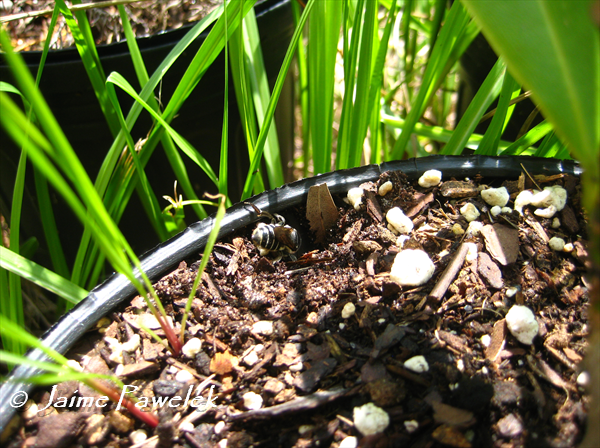 Female leaf-cutter bee (Megachile sp.) building a nest in a flower pot
Female leaf-cutter bee (Megachile sp.) building a nest in a flower pot
As you can see, we need bees, not only for the beauty they provide us, by pollinating flowering plants, but also the delicious food they help put on our plates! Help spread the word about the importance of bees to your friends, family, and neighbors. For more detailed information on bees in Florida, visit: www.floridasnativebees.com. More information on gardening for bees, and many more topics can be found at: www.helpabee.org.
BIO: Jaime Pawelek is a research assistant in the Urban Bee Lab at the University of California, Berkeley. Her love of bees started here, then followed her back home to Florida, where she researched native bees at the Guana Tolomato Matanzas National Estuarine Research Reserve, in St. Augustine. She has now returned to California and is continuing with her bee-loving journey!
What do you have planted in your garden that supports native bees? Do you have a water feature for them?
Seeds to Sprout:
Missed Tuesday’s interview with Jamie? Check it now!
Be sure to get this month’s Wonder Wednesday Lesson Plan: Honeycomb Exploration. Don’t want to miss one? Be sure to sign up for the news letter to have them delivered right to your inbox!
Did you love Jamie’s writing as much as I do? May I suggest her article “Buzzy Bee Garden Behaviors.” She even answered my Pollinator Week post question about what those (longhorn) bees were doing on the dried flax and I have been searching everywhere for info on that behavior!
Keep up with Jamie’s west coast work at the Urban bee Lab at: www.helpabee.org
Check out more of her amazing photography and east coast bee work at www.floridasnativebees.com
Check out Jamie’s GTMNERR Native bee blog!
A TED talk with Marla Spivak on bee disappearance
Bring information on bees to your Middle and high school classrooms with the documentary “Vanishing of the Bees.” Check out the shorter classroom version with accompanying education guide.
Female long-horned bee (Melissodes sp.) resting on a spent flower stem
